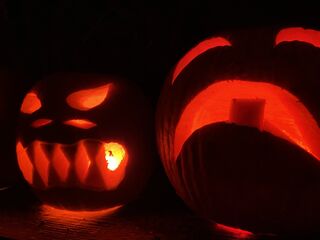Fear
Trick or Truth? Domestic Terrorism at Halloween?
Urban legends about stranger danger and halloween sadism persist. Why?
Posted November 7, 2022 Reviewed by Hara Estroff Marano
Key points
- Dressing up as monsters and superheroes affords kids the opportunity to conquer fear.
- Halloween has been wrongfully characterized as dangerous.
- As play shrinks, children's resilience declines.
Another Halloween has come and gone. The goblin costumes, the ghosts, fairy princesses, dinosaurs, pirates, and witches have been stowed away. A couple of Josh Allen number 17 jerseys showed up at the door this holiday, and so did a trick-or-treating Secret Service agent. Popular films inspired several other empowering costumes: a Mirabel of Encanto fame came begging, along with one reveler outfitted in cleverly makeshift Mandalorian armor. A Mulan and an Ariel arrived, as did somebody or other from Minecraft. One spectacular get-up turned out to be Dora Milaje Okoye. Wow! A warrior-general all the way from Wakanda!
Because adults typically accompany their children from house to house now, and because so many, young and old, are out in their neighborhoods enjoying their neighbors’ hospitality, it turns out that Halloween is usually the safest night of the year.
Still the Myth of “Halloween Sadism” Persists
Yet, though the hilarious spooky community celebration is mostly over, the frightful urban legends about Halloween sadism persist. This year a United States Senator from West Virginia warned that deadly fentanyl pills from China could and likely would be disguised as seasonal treats. This indirect state terrorism didn’t come to pass, of course. Despite persistent fears, there were also no reported injuries from finishing nails found hidden in candy apples. No strangers sprinkled rat poison on the gumdrops, either. Not this year. Nor any other year, in fact.
A string of investigators (academics, police detectives, journalists, and folklorists) who have repeatedly tried to find incidents of Halloween-related domestic terrorism came up empty. Yes, there have been isolated, bizarre instances. A murderer in Canada who wanted to collect insurance once poisoned his son at Halloween. Ill-behaved kids, pranksters here and there, have faked discovering adulterated sweets to rile up adults and police. And one unfortunate child died after apparently eating contaminated candy. But it turned out that he had instead consumed his uncle’s heroin stash. But none of those instances amounted to anonymous terrorism.
The Facts
Joel Best, a professor of sociology and criminal justice at the University of Delaware, investigated alleged “Halloween sadism” between 1958 and 2012 and found that in all years but two, there were either one or none reported. The two exceptions, in 1970 and 1971, when about a dozen incidents were reported, coincided with an unfounded opinion piece that ran in The New York Times, “Those Treats may be Tricks.” (Alas, as we know all too well now, mimetic misinformation is highly contagious.) Professor Best concluded, categorically, that “there were no instances in which an anonymous sadist caused death or injury; the data offer no justification for the claim that Halloween sadism stands as a major threat to U.S. children.” The “vast majority” of the reports to the contrary were hoaxes, and beyond that, the reports were “unfounded.” P. 137
The Roots of a Pernicious Meme
Facts aside, the pattern of panicky precaution and false reporting has a long history. In 1984, technicians from a North Carolina hospital x-rayed 500 trick-or-treat bags for evidence of sharp objects hidden in candy. To the relief of all involved, they found none. Then the next year, the popular syndicated newspaper advice columnist Ann Landers advised parents to “warn kids not to eat any treats until they have been inspected by a parent or chaperone.” The “dark side” of Halloween, she wrote, “is that hundreds of children will be injured, and some may be killed.”
Wherever did the danger arise? And who was responsible? “In recent years,” Landers insisted, “there have been reports of people with twisted minds putting razor blades and poison in taffy apples and Halloween candy.” Her conclusion: unlike in those carefree days of yore, “it is no longer safe to let your child eat treats that come from strangers.”
Enlisting Monsters to Vanquish Dread
Those of us old enough to remember days when trick-or-treating kids roamed the nearby space on their own will also recall the sense of freedom and agency that Halloween enabled. So too, dressing up as scary or dazzling or powerful entities, those familiar pirates and princesses, firefighters and sports heroes, enabled empowering fantasies.
Monsters, too, take their place in children’s emotional armamentarium. To portray a vampire, a warlock, or a ghost is, through the avenue of creative make-believe, to conquer the fear of imaginary malign beings. To prowl the neighborhood in their spooky costumes in the company of their cohort is, for kids, to overcome their fears. Wise adults will wait at the curb as their goblins go door-to-door.
Encouragingly, that bolstering, make-believe feature of Halloween has survived (even if in truncated form) into the era when adults organize indoor parties or commandeer empty parking lots for “trunk-or-treat” events. But less favorably, adult intervention has often made children bit players in events staged-managed by adults and thus left children less-well-positioned to create their own experiences. We can observe the same erosion as school recess evaporates to make way for more instructional time and as kid-organized rough-and-tumble pick-up games disappear as youth sports professionalize.

Over the last several decades researchers have noted a declining resilience among children along with an increase in impulsivity. Depression, too, is alarmingly on the rise as kids lose the opportunity to strengthen bonds as they practice their social courage in free play.
In her classic study, A Nation of Wimps: The High Cost of Invasive Parenting, Hara Estroff Marano observed a creeping timidity in American culture that has worked to deprive kids of the strengthening power of challenging, self-organized, and spontaneous play. “Learning how to handle fear in small doses,” she observed, "is how we acquire our own unique way of managing emotions.”
References
Hara Estroff Marano, A Nation of Wimps: The High Cost of Invasive Parenting, (2008); "Why Parents Should Stop Overprotecting Kids and Let Them Play An Interview with Hara Estroff Marano and Lenore Skenazy," American Journal of Play, volume 3, number 4. (2011).
Joel Best, Threatened Children: Rhetoric and Concern about Child Victims, (1993) Best, Joel (1993); Joel Best, Gerald T. Horiuchi, "The Razor-Blade in the Apple: The Social Construction of Urban Legends," Social Problems, (1985).
Ann Landers, "Twisted Minds make Halloween a Dangerous Time,” The Sunday Courier (0ctober 31, 1995) p. 7B.




